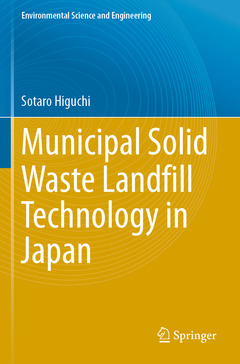Municipal Solid Waste Landfill Technology in Japan, 1st ed. 2021 Environmental Science and Engineering Series
Auteur : Higuchi Sotaro

Japan was ahead of the rest of the world when it introduced intermediate processing of municipal waste by such means as incineration in the 1960s. Owing to the small land area of the country and the difficulty in securing landfill sites, the incineration ratio of municipal combustible waste had reached 100% by the 1990s. Along with the landfill of incineration residues, proprietary technologies such as high salt leachate treatment, desalination treatment, by-product recycling, a focus on the resource of incineration residues, sea surface landfill sites, and covered type landfill sites have spread and developed since then.
This book describes the introduction of incineration facilities starting in the 1960s, landfill technology, and issues arising after 1990 following the introduction of the facilities. The necessity of a total system from incineration to landfill is explained as well. The volume is a valuable resource for countries that plan to introduce intermediate processing such as incineration and for countries that are developing a waste management policy.Following his graduation from the Faculty of Engineering at Fukuoka University in 1972, Sotaro Higuchi worked as a construction consultant planning and designing a MSW landfill. After obtaining a doctoral degree in engineering at Kyushu University, since 2001 he has been a professor in the Graduate School of Engineering, Fukuoka University, and is the director of Institute for resource recycling and environmental Controll system, Fukuoka University. The focus of his study is waste management, and his main research areas are landfills of incineration residue, desalination treatment of leachate, regeneration of landfill sites, recycling of by-product salts, and related topics. Dr. Higuchi is the chief director of the Environment Technology Network and a member of the Japan Society of Material Cycles and Waste Management. He received the Minister of the Environment Award for contributions in research and development of waste and wastewater treatment facilities in 2014.
Presents the historical transition of landfill technologies in Japan since the 1960s
Discusses issues of landfill technologies and related measures
Makes abundant use of tables and figures to facilitate readers’ understanding
Date de parution : 06-2022
Ouvrage de 324 p.
15.5x23.5 cm
Disponible chez l'éditeur (délai d'approvisionnement : 15 jours).
Prix indicatif 147,69 €
Ajouter au panierDate de parution : 06-2021
Ouvrage de 324 p.
15.5x23.5 cm



